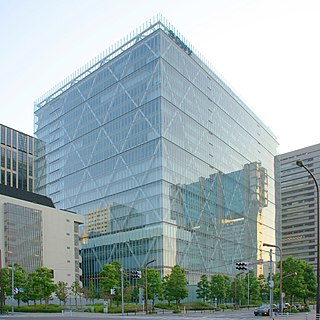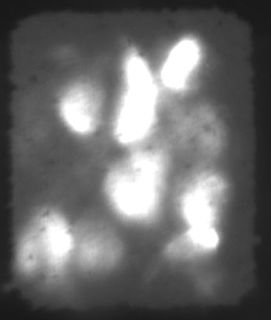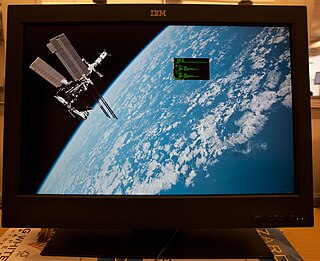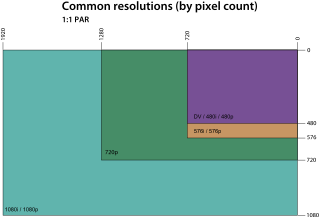
Sony Corporation is a Japanese multinational conglomerate corporation headquartered in Kōnan, Minato, Tokyo. Its diversified business includes consumer and professional electronics, gaming, entertainment and financial services. The company owns the largest music entertainment business in the world, the largest video game console business and one of the largest video game publishing businesses, and is one of the leading manufacturers of electronic products for the consumer and professional markets, and a leading player in the film and television entertainment industry. Sony was ranked 97th on the 2018 Fortune Global 500 list.
A plasma display panel (PDP) is a type of flat panel display that uses small cells containing plasma: ionized gas that responds to electric fields.

A thin-film transistor (TFT) is a special type of metal–oxide–semiconductor field-effect transistor (MOSFET) made by depositing thin films of an active semiconductor layer as well as the dielectric layer and metallic contacts over a supporting substrate. A common substrate is glass, because the primary application of TFTs is in liquid-crystal displays (LCDs). This differs from the conventional bulk MOSFET transistor, where the semiconductor material typically is the substrate, such as a silicon wafer.
A flat-panel display (FPD) is an electronic viewing technology used to enable people to see content in a range of entertainment, consumer electronics, personal computer, and mobile devices, and many types of medical, transportation and industrial equipment. They are far lighter and thinner than traditional cathode ray tube (CRT) television sets and video displays and are usually less than 10 centimetres (3.9 in) thick. Flat-panel displays can be divided into two display device categories: volatile and static. Volatile displays require that pixels be periodically electronically refreshed to retain their state. A volatile display only shows an image when it has battery or AC mains power. Static flat-panel displays rely on materials whose color states are bistable, and as such, flat-panel displays retain the text or images on the screen even when the power is off. As of 2016, flat-panel displays have almost completely replaced old CRT displays. In many 2010-era applications, specifically small portable devices such as laptops, mobile phones, smartphones, digital cameras, camcorders, point-and-shoot cameras, and pocket video cameras, any display disadvantages of flat-panels are made up for by portability advantages.

A television set or television receiver, more commonly called a television, TV, TV set, telly, or tele, is a device that combines a tuner, display, and loudspeakers, for the purpose of viewing and hearing television broadcasting through satellites or cables, or viewing and hearing a computer. Introduced in the late 1920s in mechanical form, television sets became a popular consumer product after World War II in electronic form, using cathode ray tube (CRT) technology. The addition of color to broadcast television after 1953 further increased the popularity of television sets in the 1960s, and an outdoor antenna became a common feature of suburban homes. The ubiquitous television set became the display device for the first recorded media in the 1970s, such as Betamax, VHS and later DVD. It has been used as a display device since the first generation of home computers and dedicated video game consoles in the 1980s. By the early 2010s, flat-panel television incorporating liquid-crystal display (LCD) technology, especially LED-backlit LCD technology, largely replaced CRT and other display technologies. Modern flat panel TVs are typically capable of high-definition display and can also play content from a USB device.

Liquid-crystal-display televisions are television sets that use liquid-crystal displays to produce images. They are, by far, the most widely produced and sold television display type. LCD TVs are thin and light, but have some disadvantages compared to other display types such as high power consumption, poorer contrast ratio, and inferior color gamut.

A field-emission display (FED) is a flat panel display technology that uses large-area field electron emission sources to provide electrons that strike colored phosphor to produce a color image. In a general sense, an FED consists of a matrix of cathode ray tubes, each tube producing a single sub-pixel, grouped in threes to form red-green-blue (RGB) pixels. FEDs combine the advantages of CRTs, namely their high contrast levels and very fast response times, with the packaging advantages of LCD and other flat-panel technologies. They also offer the possibility of requiring less power, about half that of an LCD system.

BRAVIA is a brand of Sony Visual Products Inc., a wholly owned subsidiary of Sony Corporation, and used for its television products. Its backronym is "Best Resolution Audio Visual Integrated Architecture". All Sony high-definition flat-panel LCD televisions in North America have carried the logo for BRAVIA since 2005. BRAVIA replaces the "LCD WEGA" which Sony used for their LCD TVs until Summer 2005.

The Sony Glasstron was a family of portable head-mounted displays, first released in 1996 with the model PLM-50. The products included two LCD screens and two earphones for video and audio respectively. These products are no longer manufactured nor supported by Sony.

The Sony Watchman is a line of portable pocket televisions trademarked and produced by Sony. The line was introduced in 1982 and discontinued in 2000.

S-LCD Corporation is a South Korean manufacturer of amorphous TFT LCD panels, owned by Samsung Electronics.

The IBM T220 and T221 are LCD monitors that were sold between 2001 and 2005, with a native resolution of 3840×2400 pixels (WQUXGA) on a screen with a diagonal of 22.2 inches (564 mm). This works out as over 9.2 million pixels, with pixel density of 204 pixels per inch, much higher than contemporary computer monitors and approaching the resolution of print media. The display family was nicknamed "Big Bertha" in some trade journals. Costing around $8400 in 2003, the displays saw few buyers. Such high-resolution displays would remain niche products for nearly a decade until modern high-dpi displays such as Apple's Retina Display line saw more-widespread adoption.
Chi Mei Corporation is a plastics producer in Taiwan. It is the largest maker of ABS resin in the world, producing about 1 million tons of ABS annually in 1999. It has factories in Tainan and Zhenjiang. It also produces acrylic glass, polystyrene, thermoplastic elastomer and synthetic rubber.
Philips Consumer Lifestyle, is a division of the Dutch multinational electronics company Philips which produces consumer electronics and small appliances. It is the only Philips division headquartered in Amsterdam, the Netherlands. The Americas division is headquartered in Stamford, Connecticut.
Sony MobileDisplay Corporation was a subsidiary of Sony Corporation and produced Low-temperature polysilicon, amorphous silicon TFT LCD panels, organic EL displays and touch screens for use in mobile products such as camcorders, digital cameras, mobile phones, automobiles, etc. Its manufacturing plants were located in Higashiura, Aichi and Tottori, Tottori, Japan. The business of the company was transferred to Japan Display Inc. on April 1, 2012.
Sharp Corporation is a Japanese multinational corporation that designs and manufactures electronic products, headquartered in Sakai-ku, Sakai. Since 2016 it has been a subsidiary of Taiwan-based Foxconn Group. Sharp employs more than 50,000 people worldwide. The company was founded in September 1912 in Tokyo and takes its name from one of its founder's first inventions, the Ever-Sharp mechanical pencil, which was invented by Tokuji Hayakawa in 1915.

The graphics display resolution is the width and height dimension of an electronic visual display device, such as a computer monitor, in pixels. Certain combinations of width and height are standardized and typically given a name and an initialism that is descriptive of its dimensions. A higher display resolution in a display of the same size means that displayed photo or video content appears sharper, and pixel art appears smaller.

Japan Display Inc. (JDI) is an LCD technology joint venture by Sony, Toshiba, and Hitachi. The Innovation Network Corporation of Japan (INCJ) financed the merger of Sony, Toshiba, and Hitachi's LCD divisions into one entity by investing two hundred billion yen.

Applied Films Corporation manufactured electrodes on glass for flat panel displays. These electrodes are used in liquid crystal displays (LCD), plasma displays, and auto-dimming car mirrors utilizing electrochromism. Major early customers were Burroughs in New Jersey, IBM in East Fishkill and Kingston, New York, numerous Asian producers of LCDs, Gentex in Holland, Michigan, Plasmaco in Highland, New York, and Samsung in Gumi, South Korea. The main method of coating these electrodes on glass was magnetron sputter deposition, specifically the planar magnetron A US patent 4166018 A, John S. Chapin, "Sputtering process and apparatus", published 1979-08-28, assigned to Airco, Inc., later assigned to BOC Group Inc. The main materials were indium tin oxide transparent electrical conductor, silicon dioxide diffusion barrier, and chromium and copper conductors.











